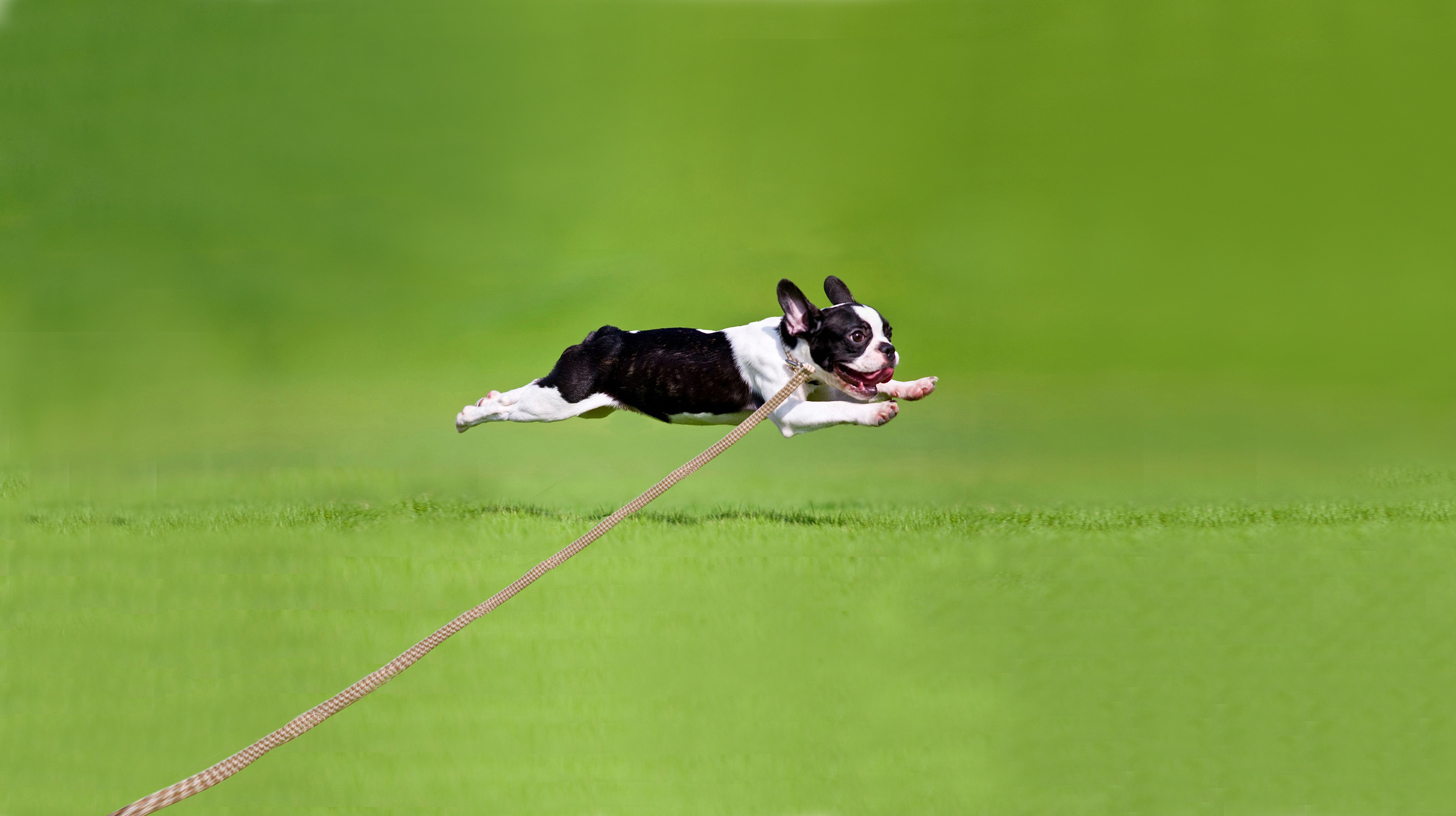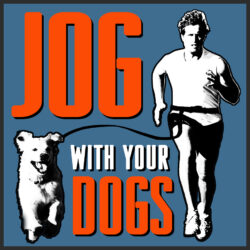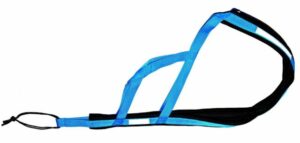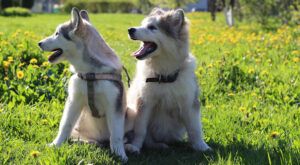
Your dog’s health should be the only concern when asking “is a collar or harness better for my dog?”
I hate to bring this up because it seems so obvious. But believe it or not, there are people that might decide between a collar or harness based on looks, what they grew up to using, or what is easier for them to put on their dog.
 Collars
Collars
Collars are the traditional way to walk your dog. They’re great for carrying tags with identification, contact information, and proof of vaccinations. Always be sure the collar is not too tight. You should be able to fit 2 fingers between the collar and your dog’s neck. A collar is convenient for a quick hand-hold if you need to unexpectedly restrain your pup.
A collar is also the most minimal, and therefore most comfortable, equipment your dog can wear but are they good for the animal on a walk or a run?
Dogs that pull on a leash can be hurt if wearing a collar. There’s strong evidence that pulling on a collar can cause thyroid gland or trachea damage. Even if your dog is well trained and doesn’t pull, there are always unexpected times when you or the dog make a sudden stop or sudden start.

It’s the advice of jogwithyourdogs.com that collars are NOT the best for your pup when walking/running. Certainly, stay away from the choke collars and prong collars that are intended to create discomfort in the animal for training purposes. Keep a collar on your pup with ID and your contact information attached in case he/she gets loose, but a harness is strongly recommended for exercising, not a collar.
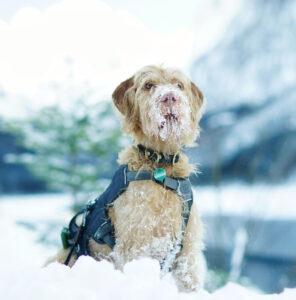 Harnesses
Harnesses
Harnesses give you control over your dog without putting a strain on their neck. Dogs are also much less likely to slip out of a harness. Many harnesses come with an adapter that turns them into a doggie seat belt – very useful if you travel in the car often.
Harnesses in general cover much more of your dog’s body and can therefore hold in more heat. So if you’re out with your dog on a warm day be aware that the harness may be contributing to the dogs discomfort. You’ll also need to make sure that the harness fits well and doesn’t rub or chafe. This usually happens around their armpits. If this chafing persists it can cause an infection.
There is a dizzying array of harness choices. How do you know what’s best for your dog? I’ve tried below to touch on some of the styles, designs and their benefits and potential drawbacks.
Training harnesses for dogs that pull
The Front-Clip Harness
If your dog pulls you when walking, the “front-clip” or “no-pull harness” is an option. This harness design helps owners gain better control over their dogs. Front-clip harnesses are often used to train dogs not to pull on their leashes.
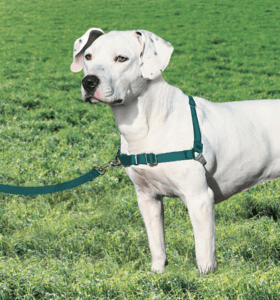
They have a safety clip in the front that attaches to a leash. This technology allows you to control the dog’s chest and shoulders, which helps stop dogs from pulling. The chest clip gives the owner control over the direction the dog is moving. It even allows for the dog to be redirected to face the owner if needed.
This is a much better way to train your dog than the choke collar, which can permanently hurt your pet.
The downside of this style of harness is that the leash on the front of the chest can tangle under the dog’s front legs if too much slack is given. Also, some dogs have a body type where the harness rubs uncomfortably in the armpit area, especially when running. Be aware of this and find an alternative if it’s irritating your dog. It’s not something that will go away or that they will get used to.
The Harness Lead
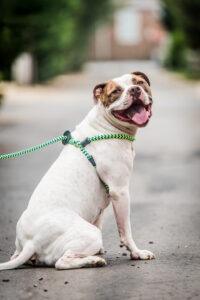
The Harness Lead is an alternative to the Front clip Harness. When your dog pulls, it feels the lead/leash put pressure around its chest. NOT around the dog’s neck which is much more delicate and vulnerable to damage.
The Harness Lead deals with a dog’s center of gravity. Your dog feels an upward lift of the harness when they pull. Dogs prefer to keep their feet on the ground, and will slow their pulling to keep them there.
Small Dog Harness
There are generally 2 styles of harness: 1.) step-in harness, 2.) pull-over harness. Some dogs don’t like the pullover style because it “pulls over” their head. Some pet stores will let you try harnesses on in-store. This may be the only way to figure out if your dog has a preference.
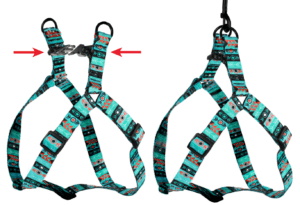
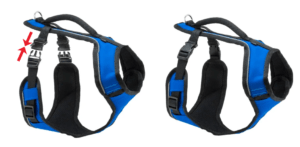
Smaller dogs are harder to see from a distance. Especially to motorists that might be moving too fast. Harnesses with reflective material are recommended to ensure that you’re visible to traffic. It’s good advice for any size dog (and even people) to wear bright or reflective materials for the early morning or evening walks.
Comfortable materials that are breathable, soft, and lightweight like mesh, or mesh panels, are recommended. Short-haired dogs usually are more comfortable in a harness with a little padding. Long-haired dogs need to have a buckle system that won’t catch their hair in the clasps.
A harness that’s adjustable around the neck and chest will keep your dog comfortable while preventing him from slipping out of the harness.
Make sure the harness has a chest strap that is low enough and doesn’t strain the neck. After all, the point of a harness is to prevent neck/trachea issues that collars may bring.
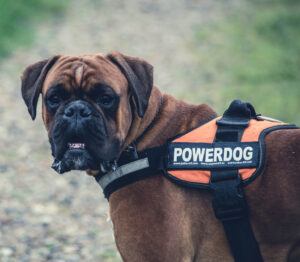 Medium to Large Dog Harness
Medium to Large Dog Harness
Needless to say, a larger dog will need sturdier materials in their harness than a toy dog’s harness. Many come with a handle located above the dog’s shoulder. This handle is a convenient way to take quick, and complete control of the dog in a pinch.
Harnesses come in nylon and leather and each has its benefits. Leather may conform to the dog’s body over time and be more comfortable when broken in. Nylon is more water/moisture resistant, and for that reason, it will stay softer than a leather harness that gets soaked in the rain repeatedly. Also, many nylon harnesses can be tossed in the washing machine when dirty.
Though a bigger dog is more visible than a small one, reflective panels or reflective details are advised for low light walks/runs. Especially if your animal has a dark-colored coat. Led lights are often attached to harnesses but batteries wear out and need to be replaced.
Similar considerations are made for larger dog harnesses as the ones mentioned for the little guys: breathable, materials, short-haired dogs like a little padding. Long-haired dogs need to have a safe buckle system, adjustable harnesses make your dog comfortable and safer.
Make sure the harness has a chest strap that is low enough and doesn’t strain the neck. Remember: The point of the harness is to prevent neck/trachea injury that collars often bring.
Specialized Harnesses
Canicross, or CaniX, is a new sport that’s quickly gaining popularity. The harnesses for this sport are highly technical and based on sled dog harnesses. The harness is attached to a leash, that’s attached to a belt around the runner’s waist. As the pair competes in a trail/cross county race (no paved surfaces). The runner is pulled by the K9 partner to a faster time than he could’ve done by himself. There are also versions of this where the human is on a mountain bike. Here’s a link to a video of that fast and exciting action.
Tracking Harness
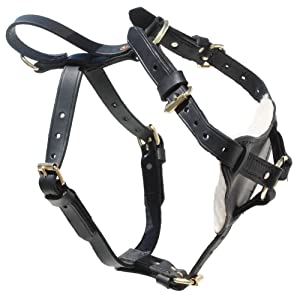
Training a dog to track creates a useful and special bond between humans and dogs. The dog feels a sense of accomplishment, and that fills the owner with pride.
Tracking harnesses require specialized features like a minimal design that allows for quick and agile movement while still giving you control. High-quality tracking harnesses are often made of leather that won’t easily get damaged.
Tactical Harness
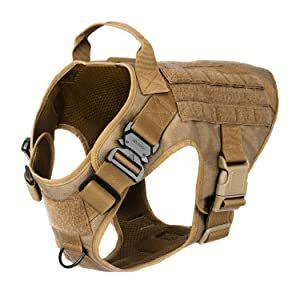
Tactical is a category of harness that includes everything from military, to police, to service (seeing-eye or wheelchair assist). It may have lettering reading “Service Dog Do Not Pet” and it may have pockets with medical supplies. Some come with detachable pockets for supplies. Patches come with various messages, such as “Do Not Pet” or “Please Give Me Space”, or a custom message of your choosing.
These vests are often worn for longer stretches of time, and the vest should be made of soft materials designed to stay comfortable longer.
Conclusion
Your dog should have a collar and a harness. They don’t need to be worn together.
Think of collars as a ID necklace for your pup ( I guess that’s why the military calls them dog tags ). It’s on your dog in case they get loose and the collar should have your phone number on it.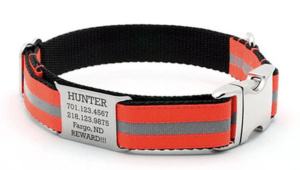
We take our dog out to walk with a collar only for that 2-3 minute midnight bathroom break before bedtime. Never for long walks or runs. Harnesses are best for exercise as they are kinder to your animal’s body.
We’ve attempted to give a sampling of harness design and functionality here, but I’m afraid it just scratches the surface. It’s hard to say what’s the best harness for your dog. Is your dog big or little, long hair or short hair, pulls uncomfortably on the leash, or is well behaved, needs special adjustments for a good fit, or is a common body type?
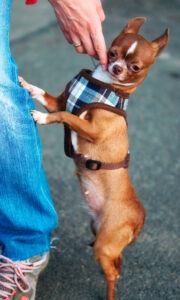 When you find the appropriate harness for your dog, you will both be happier. Be sure to check the fit often. Young dogs can quickly out grow a harness that fit well just a few days ago. Buy a harness that you can adjust as they grow. And remember, like collars, a harness shouldn’t be too tight. Two fingers should fit snugly, but comfortably, between the harness and dog’s coat.
When you find the appropriate harness for your dog, you will both be happier. Be sure to check the fit often. Young dogs can quickly out grow a harness that fit well just a few days ago. Buy a harness that you can adjust as they grow. And remember, like collars, a harness shouldn’t be too tight. Two fingers should fit snugly, but comfortably, between the harness and dog’s coat.
We always suggest that you talk to your veterinarian about important choices. They may have suggestions and help talk you through the options and find the best fit for your dog.
